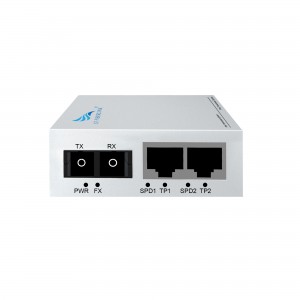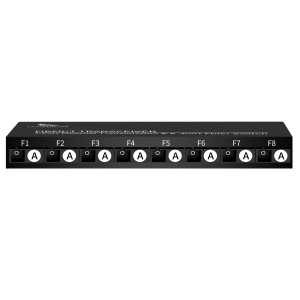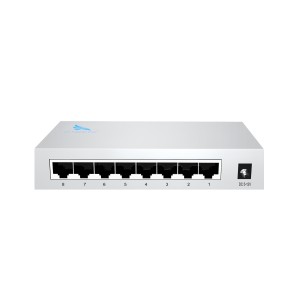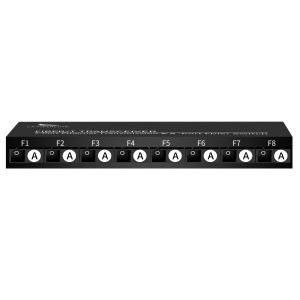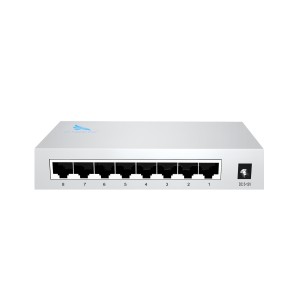2-port 10/100/1000M WDM Media Converter (Single-mode Single-fiber SC)B-end
2-port 10/100/1000M WDM Media Converter (Single-mode Single-fiber SC)B-end
Product Features:
Grandly launched the optoelectronic single-mode single-fiber Gigabit B terminal, 2-port single-mode single-fiber Gigabit photoelectric conversion equipment, and Gigabit Ethernet transceiver of Huizhou Changfei Optoelectronics Technology Co., Ltd. The overall transmission solution is committed to providing high-quality products and services to global customers.
The optoelectronic single-mode single-fiber Gigabit B terminal is designed to provide efficient and reliable optical fiber transmission. The terminal has a light and a power interface to ensure a seamless and stable connection. It supports single-mode single-fiber transmission, enabling long-distance data transmission with minimal signal loss. The terminal also has a wide voltage power supply function, ranging from DC5-12V, which is widely used and suitable for various applications. The ports support 4KV lightning protection, and you can trust the durability of this terminal even in harsh weather conditions.
Our 2-port Single-Mode Single-Fiber Gigabit Optical-to-Electrical Conversion Device is an advanced solution for converting optical signals to electrical signals and vice versa. The device can realize the seamless integration of optical fiber network and traditional Ethernet. It is designed to support gigabit transfer speeds, ensuring fast and reliable data transfers. With its compact and efficient design, the device is suitable for a variety of environments and applications.
Our Gigabit Ethernet transceivers are perfect for those who need a reliable, efficient Ethernet transceiver. It provides high-speed Gigabit Ethernet connections for personal and business users. It supports 10KB jumbo frames for efficient data transfer, ideal for bandwidth-intensive applications. Additionally, the transceiver’s low power consumption ensures energy efficiency without compromising performance.
Our products have more than 360 distributors and agents in more than 100 countries, and are well received by customers all over the world. Our success is attributed to our extensive research and development experience in the field of optoelectronics, and our commitment to providing high-quality products and services. We are proud of our scientific research patents for optoelectronic products, which enable us to provide cutting-edge solutions to our valued customers.
The photoelectric single-mode single-fiber gigabit B terminal, 2-port single-mode single-fiber gigabit photoelectric conversion equipment, and gigabit Ethernet transceivers all meet the highest industry standards. These products feature a wide temperature operating range, dynamic LED indicators, and an easy installation process designed to enhance your connection experience. The iron shell design ensures durability and protection, and the IP30 rating keeps out dust and debris.
In a word, Huizhou Changfei Photoelectric Technology Co., Ltd. is committed to providing you with advanced transmission solutions and high-quality products. Our optoelectronic single-mode single-fiber Gigabit B-terminals, 2-port single-mode single-fiber Gigabit optical conversion devices and Gigabit Ethernet transceivers provide reliable, efficient, and seamless connectivity options. Experience the difference in our products and join our global customer base in over 100 countries.
What This Product Does
◇ CF-101GSW-20B is a gigabit media converter, providing a gigabit RJ-45 port and a gigabit SC fiber port, which can convert between electrical and optical signals.
How This Product Works
◇ CF-101GSW-20B adopts WDM (wavelength division multiplexing) technology, helping send and receive data at a distance of up to 20 km with only a single mode fiber, which saves half of the cable deployment cost for customers. CF-101GSW-20B transmits data at 1310 nm wavelength and receives data at 1550 nm wavelength on optical fiber. Therefore, the terminal device used in conjunction with the CF-101GSW-20B should send data at a wavelength of 1550 nm and receive data at a wavelength of 1310 nm. CF FIBERLINK another media converter CF-101GSW-20A is one of the products that can cooperate with CF-101GSW-20B.
Other Features
◇ Besides, this media converter can be used as a standalone device (no rack required) or used with CF FIBERLINK’s CF-2U14 rack for auto MDI/MDI-X in TX port in which duplex mode is automatically negotiated.
Technical Parameter:
| Model | CF-101GSW-20B | |
| Interface Characteristics | ||
| Fixed Port | 1* 10/ 100/ 1000Base-T RJ45 port
1* 1000Base-X uplink SC fiber port |
|
| Ethernet Port | 10/ 100/ 1000Base-T auto-sensing, full/half duplex MDI/MDI-X self-adaption | |
|
Twisted Pair Transmission |
10BASE-T: Cat3,4,5 UTP(≤100 meter)
100BASE-T: Cat5e or later UTP(≤100 meter) 1000BASE-T : Cat5e or later UTP(≤100 meter) |
|
| Optical Port | Default optical module is single-mode single-fiber 20km, SC port | |
| Wavelength/Distance | A-end: RX1310nm / RX1550nm 0 ~ 40KM
B-end:RX1550nm/ RX1310nm 0 ~ 40KM |
|
| A-end: RX1490nm / RX1550nm 0 ~ 120KM
B-end:RX1550nm/ RX1490nm 0 ~ 120KM |
||
| Chip Parameter | ||
| Network Protocol | IEEE802.3 10BASE-T, IEEE802.3i 10Base-T,
IEEE802.3u 100Base-TX, IEEE802.3u 100Base-FX, IEEE802.3x IEEE802.3ab 1000Base-T;IEEE802.3z 1000Base-X; |
|
| Forwarding Mode | Store and Forward(Full Wire Speed) | |
| Switching Capacity | 4Gbps | |
| Buffer Memory | 3Mpps | |
| MAC | 2K | |
|
LED Indicator |
Fiber | FX(green) |
| rate | SD/SPD1 (green)
SPD2: 100/ 1000 (green) |
|
| Data | TP (green) | |
| Single / duplex | FDX (green) | |
| Power | PWR (green) | |
| Power | ||
| Working Voltage | AC:100-240V | |
| Power Consumption | Standby<1W, Full load<5W | |
| Power Supply | DC:5V/2A industrial power supply | |
| Lightning protection &Certification | ||
| Lightning protection | Lightning protection: 4KV 8/20us, Protection level: IP30 | |
| Certification | CCC;CE mark, commercial; CE/LVD EN60950;FCC Part 15 Class B; RoHS | |
| Physical Parameter | ||
| Operation TEMP | -20~+55°C;5%~90% RH Non condensing | |
| Storage TEMP | -40~+85°C;5%~95% RH Non condensing | |
| Dimension (L*W*H) | 94mm* 71mm*27mm | |
| Installation | Desktop, CF-2U14 slot rack | |
Product Size:
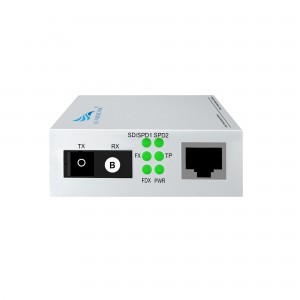
product application diagra:

How to choose a fiber optic transceiver?
Optical fiber transceivers break the 100-meter limitation of Ethernet cables in data transmission. Relying on high-performance switching chips and large-capacity caches, while truly achieving non-blocking transmission and switching performance, they also provide balanced traffic, isolation and conflict. Error detection and other functions ensure high security and stability during data transmission. Therefore, fiber optic transceiver products will still be an indispensable part of actual network construction for a long time. So, how should we choose fiber optic transceivers?
1. Port function test
Mainly test whether each port can work normally in the duplex state of 10Mbps, 100Mbps and half-duplex state. At the same time, it should be tested whether each port can automatically select the highest transmission speed and automatically match the transmission rate of other devices. This test can be included in other tests.
2. Compatibility test
It mainly tests the connection ability between the optical fiber transceiver and other devices compatible with Ethernet and Fast Ethernet (including network card, HUB, Switch, optical network card, and optical switch). The requirement must be able to support the connection of compatible products.
3. Cable connection characteristics
Test the fiber optic transceiver’s ability to support network cables. First, test the connection ability of Category 5 network cables with lengths of 100m and 10m, and test the connection ability of long Category 5 network cables (120m) of different brands. During the test, the optical port of the transceiver is required to have a connection capability of 10Mbps and a rate of 100Mbps, and the highest must be able to connect to a full-duplex 100Mbps without transmission errors. Category 3 twisted pair cables may not be tested. Subtests can be included in other tests.
4. Transmission characteristics (transmission loss rate of data packets of different lengths, transmission speed)
It mainly tests the packet loss rate when the optical fiber transceiver optical port transmits different data packets, and the connection speed under different connection rates. For the packet loss rate, you can use the test software provided by the network card to test the packet loss rate when the packet size is 64, 512, 1518, 128 (optional) and 1000 (optional) bytes under different connection rates. , the number of packet errors, the number of packets sent and received must be more than 2,000,000. Test transmission speed can use perform3, ping and other software.
5. The compatibility of the whole machine to the transmission network protocol
It mainly tests the compatibility of fiber optic transceivers to network protocols, which can be tested in Novell, Windows and other environments. The following low-level network protocols such as TCP/IP, IPX, NETBIOS, DHCP, etc. must be tested, and the protocols that need to be broadcast must be tested. Optical transceivers are required to support these protocols (VLAN, QOS, COS, etc.).
6. Indicator status test
Test whether the status of the indicator light is consistent with the description of the panel and the user manual, and whether it is consistent with the current status of the fiber optic transceiver.








